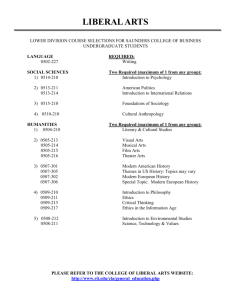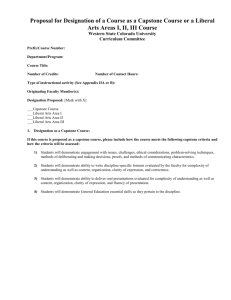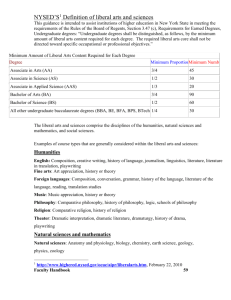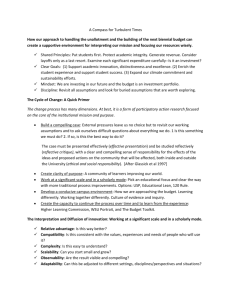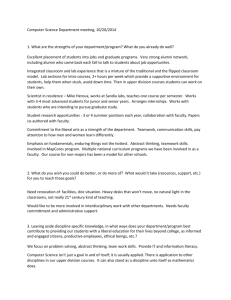The Twin Elements of Learning: Knowledge and Judgment
advertisement
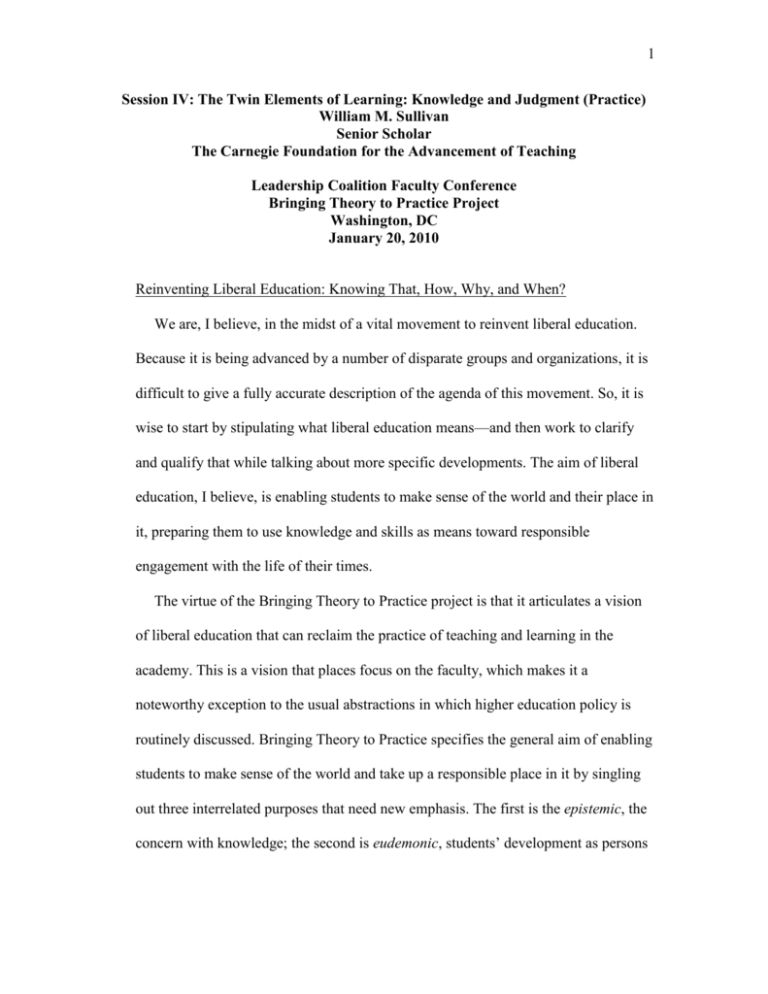
1
Session IV: The Twin Elements of Learning: Knowledge and Judgment (Practice)
William M. Sullivan
Senior Scholar
The Carnegie Foundation for the Advancement of Teaching
Leadership Coalition Faculty Conference
Bringing Theory to Practice Project
Washington, DC
January 20, 2010
Reinventing Liberal Education: Knowing That, How, Why, and When?
We are, I believe, in the midst of a vital movement to reinvent liberal education.
Because it is being advanced by a number of disparate groups and organizations, it is
difficult to give a fully accurate description of the agenda of this movement. So, it is
wise to start by stipulating what liberal education means—and then work to clarify
and qualify that while talking about more specific developments. The aim of liberal
education, I believe, is enabling students to make sense of the world and their place in
it, preparing them to use knowledge and skills as means toward responsible
engagement with the life of their times.
The virtue of the Bringing Theory to Practice project is that it articulates a vision
of liberal education that can reclaim the practice of teaching and learning in the
academy. This is a vision that places focus on the faculty, which makes it a
noteworthy exception to the usual abstractions in which higher education policy is
routinely discussed. Bringing Theory to Practice specifies the general aim of enabling
students to make sense of the world and take up a responsible place in it by singling
out three interrelated purposes that need new emphasis. The first is the epistemic, the
concern with knowledge; the second is eudemonic, students’ development as persons
2
as well as minds; and the third, civic purpose addresses the dimension of engagement
with larger values and responsible participation in the life of our times.
In what follows, I want to build on this approach which Don Harward has done so
much to articulate and sustain.
1. I will begin by asking the (rhetorical) question, “If this is so evidently a good
thing, then why doesn’t everyone just do it?” The answer, of course, involves
the difficult matter of what we might think of as structural constraints that
work to limit today’s practices of academic pedagogy to a one-sided emphasis
upon “knowing that.” This limitation can be summed up as giving nearlyexclusive attention to analytical reasoning or as it is often called, “critical
thinking.”
2. Against this as background, I want to insist that the reconstruction of liberal
education that we seek requires going beyond an exclusive concern with
“knowing that” to include educating students’ capacity to “know how” as
well. This is the realm of practical reasoning. Practical here connotes not
only “skills,” but the ability to configure and use knowledge as experts “solve
problems.”
3. I will argue that for real liberal education, “knowing that” and “knowing
how,” even taken together, are not enough. They demand a further exploration
that extends to “knowing why” and “knowing when.” This has traditionally
been called practical wisdom or good judgment.
4. In conclusion, I want to emphasize what this perspective on liberal learning
means for faculty. It requires a shift from an identity as a disciplinary
3
specialist with some applied teaching skills toward an understanding of the
liberal arts faculty person as a discipline-using educator concerned in every
activity with the larger goals of liberal learning.
Why Doesn’t Everyone Just Do It?
The need to unite the three Bringing Theory to Practice goals—knowledge, student
development, and moral and civic engagement—might seem (as they do to me) such a
compelling conception of college education that it becomes hard to grasp how it could be
by so many institutions neglected. More must be at work than simply myopia, sloth, or
bad will. Rather, our universities and colleges appear to be in the grip of some other
conception of their educational mission that makes the unified conception animating this
conference difficult to grasp and even calls out resistance to it. One obvious candidate is
the ascendancy of the research ideal as the source of authority and prestige in the
academy. As is well-documented, in the course of the past century this has worked to the
detriment of the collegiate ideal of educating for cultural participation and civic
leadership.
But, why has the ascendant research ideal been able to eclipse liberal education and
the college ideal within American higher education? Could it be the unintended
consequence of a larger, mostly positive development? I mean the remarkable global
expansion of university education over the past half-century. This represents a
remarkable diffusion of an institutional model, along with a powerful ideal of knowledge
and conception of free personhood, derived from European and American prototypes.
While it is common to claim that this vast expansion of higher education worldwide is
about training personnel for more intellectually demanding occupations, there is little
4
evidence to show that universities do a particularly good job of preparing people for
carrying functions in the occupational order. On the contrary, if proof be needed, it is
telling that every field does most of that preparation in the work setting itself, or in hybrid
teaching contexts such as teaching hospitals and clinics in the health professions.
What universities mostly do, according to the research of institutional sociologists
John Meyer and colleagues at Stanford University, is to certify individuals without
actually preparing them to meet the demands of occupational roles. This view points
away from a functional explanation of the rising prominence of universities. Instead,
what comes into view is their extraordinary role in propagating a distinctive culture. In its
turn, this culture shapes the outlook of increasing portions of the population of modern
societies. Universities teach respect for, and at least basic understanding of, a mode of
thinking that has come to be identified with “rationality” and modern culture itself. This
is analytical thought: the capacity to understand and manipulate symbolic discourses.
These discourses are made up of symbols that translate particular objects or events into
general concepts plus rules for combining and manipulating such symbols. It is this
culture of analytical thinking that links higher education to the occupational demands of
the modern economy. Meyer and his colleagues argue that it is not primarily through the
direct training of certain capacities so much as by cultivating a temper of mind that
higher education has achieved its current function as a near-universal gatekeeper for the
more prestigious and remunerative positions.
The culture spread by the university, then, puts a premium on formal knowledge,
abstracted from context and narrative particularity. Such thinking is held to be a superior
kind of knowledge, ultimately “applicable” to practice through formal techniques for
5
deducing results according to general formulas. Over time, that model of knowledge has
become an unquestioned canon according to which intellectual disciplines are defined
and criticized. This model has allowed the university to distinguish itself from more
“primitive” claims to knowledge, like those derived from mere craft or experience.
According to the institutionalist sociologists, the deeper function of higher education is
induction into this culture of criticism and evidence, a culture that is universal in its
claims and understands itself as the cutting edge of humanity’s forward progress.
Within this perspective, the liberal arts ideals and practices that emphasized
transmitting heritage, including analytical disciplines but focused on making sense of the
world and one’s possible place in it, do not measure up to the standards of such “modern’
knowledge. The hidden constraint, perhaps, is just this prejudice about what knowledge is
and therefore what “higher” education must concern itself with, namely induction into the
culture of “critical thinking.” What is missing in this now-regnant knowledge culture is
any recognition that the detached, analytical stance is, as John Dewey among other
philosophers argued intensely, only one phase within the larger process of human
experience. This larger process, which Dewey called “inquiry,” is guided by ends that are
eudemonic and civic as much as epistemic. Or rather, we could say that the formation of
human identity is the long-term goal and one that encompasses the moral and practical as
well as theoretical dimensions of inquiry and understanding.
The failure of the university knowledge culture to be self-reflective about its own
limits is surely linked to its apparent inability to avoid communicating to many a
weakening of meaning and, at its extreme, a kind of nihilism, even as it expands
scientific knowledge and technological capacities. And it is to address these “blind
6
spots,” or unintended consequences of the modern knowledge regime’s taken-for-granted
assumptions, that Bringing Theory to Practice articulates its own richer and deeper vision
of college education.
The educational practices of today’s universities and colleges typically direct students’
attention to mastering procedures for describing particular events and objects in terms of
general concepts. The relation of this training to students’ struggles for meaning and
orientation in the world, let alone ethical judgment, is all too rarely given curricular
attention or pedagogical emphasis. A recast liberal education, however, must go beyond
the purely analytical to provide their students with experience and guidance in using such
analytical tools to engage in deliberation about action. That emerging model of liberal
learning will, I believe, become centered upon teaching a wider conception of thinking,
one that includes “knowing how” as well as the “knowing that” of the analytical
disciplines.
“Knowing How:” the Key Role of Practical Reasoning
To appreciate the contrast between the typical agenda of analytical or critical thinking
and this richer conception of “practical reasoning,” consider some examples. These are
drawn from the “Life of the Mind for Practice” seminar described in a recent book I have
co-authored with Matthew S. Rosin, entitled A New Agenda for Higher Education: A Life
of the Mind for Practice (Jossey-Bass, 2007). The book is based upon a research seminar
convened by the Carnegie Foundation for the Advancement of Teaching that
intentionally brought together educators from professional fields as well as liberal arts
disciplines. The intent was to examine the ways in which a common focus on teaching
students to reason in context might provide a means for bridging the often deep campus
7
divides between the arts and sciences and the professional programs. Entitled, “A Life of
the Mind for Practice,” the seminar included teachers of the liberal arts side-by-side with
faculty from medicine, law, education, and engineering.
Consider first an engineer at the beginning of her career. A recent graduate, she is
skilled in the analytic techniques she learned in her engineering program. But she finds
herself working on an international project for the first time, collaborating with engineers
from other nations who define their work differently than she does. How can these
engineers work together, in a way that meets the various needs of the client, the
employer, and the engineers themselves? In an engineering course profiled in A New
Agenda for Higher Education, engineering students supplement the analytic skills learned
in their engineering courses with knowledge drawn from the humanities and social
sciences about how the engineering profession and its history differs across nations.
Through assignments that require students to imagine the work of engineers in other
societies and its ramifications for their own conduct, and vice versa, the course introduces
students to important knowledge and skills—drawn from both the liberal arts and the
engineering profession—for an increasingly global professional world and workplace.
Or consider another course highlighted in the Report: “Human Biology.” This course
provides students with an introduction to some of the key findings of contemporary
biology. But the course gets its significance from questions about the human import of
these scientific discoveries. Rapidly advancing biological knowledge—think of
genomics, for instance—is increasingly important to the ability to act well as voter and
citizen, and even as a member of one’s family. Think of the expanding range of decisions
that have sprung up in the face of serious or terminal illness and end-of-life care. As
8
advances in biological science and medical technology have extended life, they have also
increased the burden of judgment and decision upon both health care professionals—
which some of the students in the course will become—and families. How, then, to think
about these matters so as to be able to act well in a context where there is real
disagreement about the basis for judgment?
These questions arise from the students’ actual or anticipated practical involvements
and commitments as responsible participants in society. In that sense, they have an
intrinsic civic dimension. Finally, though, they are questions that stimulate the practical
imagination. Among the several dimensions of personal identity, it is the practical
imagination that proposes what we can make of our lives, and the things we may hope
for, individually and together. The scope of the practical imagination either expands or
contracts students’ capacities to engage with their lives in resourceful, reflective ways. It
was Aristotle, one of history’s great educators, who said that the institutions of a city
needed to be aligned in order to shape its citizens’ acquisition of knowledge, skill, and
character so that they would care about their community and have the ability to contribute
to its welfare. Schools, like his Lyceum, were to be organized to concentrate this
formative process. We can see Bringing Theory to Practice as standing in this vital
tradition of forming the practical imagination as well as inculcating formal knowledge.
The faculty members gathered in the “Life of the Mind for Practice” seminar found
surprising resonance across the professional-liberal arts divide. That is, they found
common ground and common cause around a specific pedagogical intention. All wanted
to provides students with more than formal knowledge and analytical skill, important as
these are in college education. They also aimed to provide students with opportunities to
9
bring this knowledge and skill together in pursuit of important practical purposes that
contribute to the life of the world. On this theme, the professional school faculty found
they had a good deal to teach. That is because professional education must provide space
for aspiring professionals to learn how to thinking like professionals in making judgments
of importance amid the uncertain conditions of practical experience. (This often goes
against the academic grain of professional schools, so that clinical teaching often acquires
a certain stigma of an “impure” activity compared to the exposition of theoretical
knowledge.)
In courses such as those described in A New Agenda for Higher Education, in both the
liberal arts and sciences and in professional fields, students learn to frame their thinking
through interplay of theoretical knowledge drawn from the academic disciplines and their
particular loyalties as citizens, as possible future engineers, or future nurses or physicians
or pharmacists, and as persons with responsibilities for others. Through experiences such
as these courses provide, students can explicitly learn how to move fluidly between the
distanced, external stance of analytical thinking—the “third person” point of view typical
of most academic thinking, and the “first and second person” points of view that are
internal to acting with others in a situation.
This is practical reasoning: the back-and-forth between general knowledge and the
challenges and responsibilities that come with particular situations, an ongoing process of
reflection whose end is the formation of habits of critical judgment for action. The
pedagogical vehicles for teaching this movement between viewpoints spans the
professional and arts and sciences disciplines: the case study; literary and historical
exploration of character and response to challenge; the simulation; participation and
10
reflection upon actual involvements in the world. But their common feature is recognition
that in practical reasoning it is always the involved stance, the point of view internal to
purposeful human activity, which provides the ground and the goal for critical, analytical
reasoning.
Knowing Why and Knowing When: Fostering Practical Wisdom
The professional teaching practices that are of value to liberal education, however, are
principally those that are organized to develop just this kind of engaged, or practical,
reasoning. The pedagogical vehicles professional education employs in the development
of such practical reasoning are varied. They range from case studies, through simulations
of practice, to guided responsibility in actual practice. But through all these methods, the
challenge for students is to bring together knowledge, skill, and the dispositions
appropriate to the profession in flexible, integrated ways. The thinking embodied in such
judgment and action is practical reasoning. This kind of reasoning involves “knowing
how” to make knowledge relevant to actual persons in uncertain situations. But it also
necessitates engaging with questions of purpose and value: “knowing why” some
decision is right and indeed “knowing when” such-and-such an intervention is
appropriate.
Unlike purely technical judgment, which employs methods to achieve pre-given ends,
practical judgment involves the blending of formal knowledge with the concrete and
value-laden dimensions of the situations of professional work. The pedagogies of
professional education, then, necessarily involve a directly moral dimension: they must
teach students what the profession stands for; they must seek to be persuasive advocates
11
for the profession’s highest standards of practice. By necessity, this is unapologetically
formative education with public responsibility in view.
This, I want to argue, provides a useful analogy to the kind of educational experience
that all students need in order to give structure and point to their learning. The pursuit of
practical wisdom is the deeper point of liberal learning. Students need not only to learn a
good deal about the world and their place in it. They also must learn how to use
knowledge and reflection to inform their judgment in complex situations. And they need
educational experiences that can spur them to shape their own lives for critical
engagement with their future careers and responsibilities. To achieve these aims,
however, liberal learning must also be concerned with developing students’ practical
judgment.
The kind of integrated education we are seeking is an effort to resolve a paradox that
perplexes many modern individuals and institutions. On the one hand, progress in
academic disciplines is like the division of labor that underlies economic growth: by
focusing on a single criterion it is possible to do progressively better at attaining it. On
the other hand, where what matters is integration among several goals—as in professional
practice and in civic life, decisions often cannot be broken down into single-goal issues
but the several goals must be blended, and compromised, with other goals. In such
situations—and most of life, especially civic life with others consists of such situations—
the premium is on holistic practical judgment.
Implications for Faculty Roles and Identities
For much of the past century, college and university faculty have aspired to the
identity of disciplinary specialist within an intellectual regime of ever more specialized
12
research programs. But if the foregoing is true, this is not the proper self-understanding
for educators in their role as guides in the realm of liberal education. An interesting
analogy from another profession may help illuminate the shift in understanding that is
required. Medicine has long appealed to the canons of physical science as a model, and
many physicians have presented themselves to the public, and often to themselves in their
education and training, as essentially embodiments of applied science. However, in a
recent study of physicians’ ways of reasoning, Katherine Montgomery argues that, “faced
with a patient, physicians do not “proceed as they and their textbooks often describe it:
top-down, deductively, ‘scientifically.’” Instead, they reason from cases. (Katherine
Montgomery, How Doctors Think: Clinical Judgment and the Practice of Medicine,
(New York: Oxford University Press, 2005), p. 46)
The starting point for all case-based reasoning, Montgomery’s study shows, is
neither deduction from general principles nor induction from the particulars to a universal
concept. Instead, doctors form hypotheses about the possible causes of a particular
patient’s situation, then test those possibilities against details revealed by closer
examination of the patient. This is a “circular, interpretive procedure” that moves
between “generalities in the taxonomy of disease and the particular signs and symptoms
of the individual case.” This intellectual movement proceeds “until a workable
conclusion is reached” {Montgomery, p. 47}. The reasoning process at the center of this
activity is the interpretive circle is recognizable as a form of practical reasoning. The case
narratives that physicians construct are not mere conjecture or poetic flights of
speculation. Case narratives put conjectures to the test. They employ analytical
knowledge through the interpretive work of isolating probable causes of illness by
13
eliminating alternative possibilities—that is, “differential diagnosis.” Thus, Montgomery
concludes that analytical modes of explanation alone simply cannot achieve the
integrated forms of understanding that medical professionals produce through this kind of
practical reasoning.
The crucial point, insists Montgomery, is that case reasoning is not a holdover from
the pre-scientific past. Rather, it is “the best means of representing the exercise of clinical
judgment.” As such, case reasoning is the indispensable foundation of all medical skill.
Montgomery concludes that we must recognize that medicine is more than a science. It is
a complex practice of healing in which “diagnosis and treatment are intensively scienceusing activities,” though not “in and of themselves, science” (Montgomery, pp. 46, 52).
In an analogous way, I submit that liberal arts teaching of the kind we have been
discussing at this conference is not the “application” of disciplinary knowledge. Nor is it
identical to induction into particular arts and sciences disciplines, as is typical of
“introductory courses” in many fields. These are all versions of the educator as
disciplinary specialist. Rather, the kind of liberal education we are seeking requires a
different understanding of the liberal arts teacher as an ‘intensively discipline-using”
educator whose aim is practical wisdom rather than specialized knowledge in itself.
Such a self-understanding is, I suspect, already widespread in the ranks of liberal arts
faculties, among those who feel a “calling” to this kind of work. But it goes against the
grain of the academy’s more fashionable model of disciplinary specialist. If a genuine
reinvention of liberal education is to succeed, it will require that this alternative faculty
identity become public, recognized, supported, and advanced.
14


